Table of Contents
Introduction to eProcurement
eProcurement is defined as a digital B2B business process that utilizes internet technology to centralize purchasing workflows and streamlines business transactions like procuring goods and services to reduce costs and improve purchasing processes. eProcurement software replaces paper-based operations by automating traditional procurement processes and helps analyze spend for strategic cost-saving operations between finance and procurement. eProcurement software integrates spend analysis, eSourcing, e-auctions, procure-to-pay (P2P), marketplaces, and contract management. The centralized system increases efficiency and reduces the overall cost of procurement.
Simfoni.com Tweet
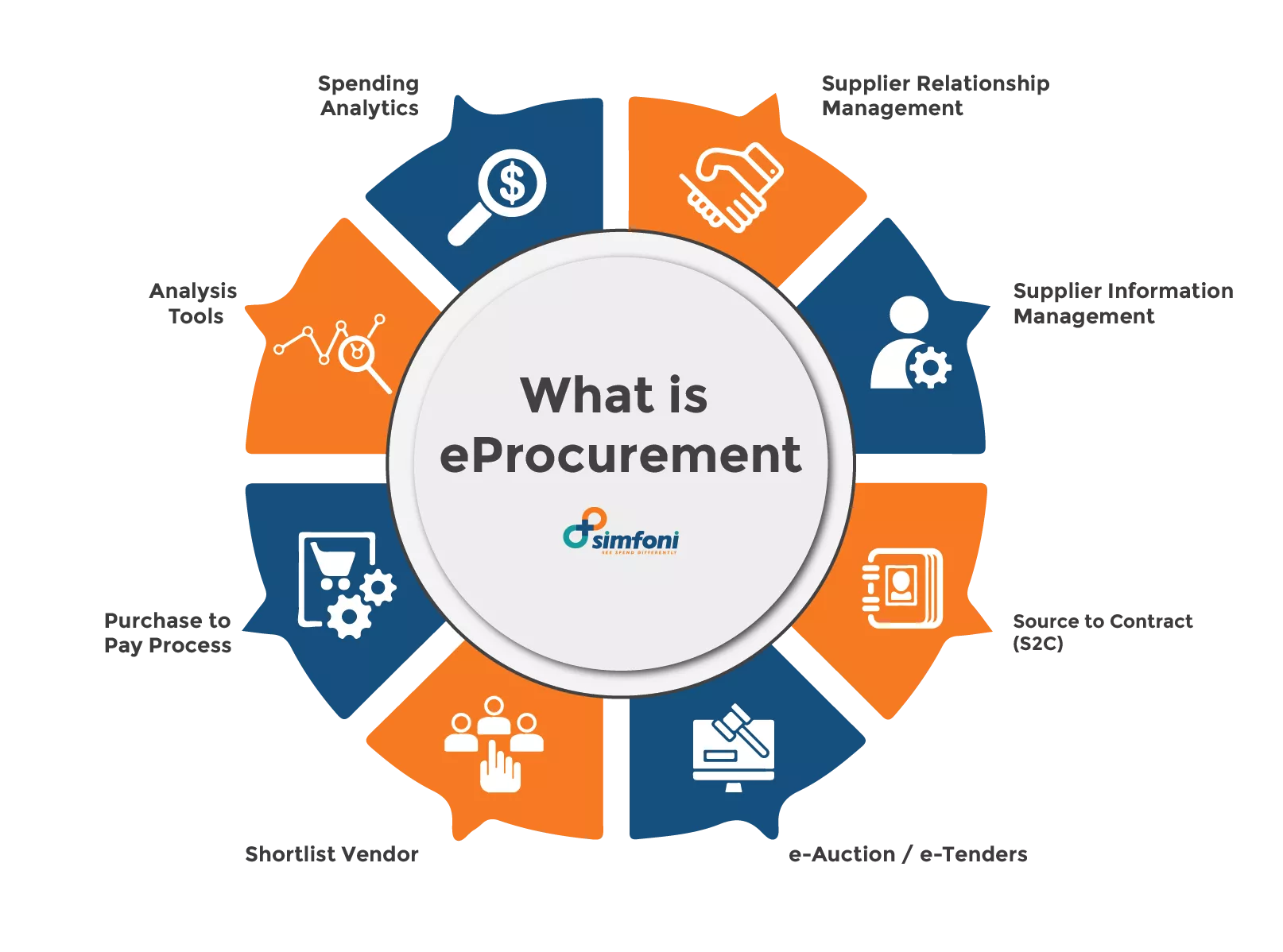
You’ve likely heard of e-procurement if you live in a digital environment. Using internet technology, e-procurement allows businesses to automate their business procedures and transactions. If you’re an entrepreneur, knowing how it works might be quite beneficial to your company. Understanding how to put it into practice is equally crucial for your business. In Simfoni platform will provide you with useful information regarding the benefits of e-procurement, the types of procurement methods available, and the tools needed to execute them.
Definition of eProcurement
Electronic procurement, or e-procurement, is when a company utilizes the internet (or occasionally an intranet) to acquire the goods and services it needs to run its business. A computerized workflow replaces paper-based operations, streamlining all parts of the purchase process.
What is eProcurement (Electronic Procurement)?
The practice of purchasing and selling materials and services through the Internet is known as e-procurement. It varies from e-commerce in that it utilizes a supplier’s closed system, which is usually only accessible to registered users. When correctly implemented, e-procurement creates a direct relationship between a company and a supplier, making interactions like bids, purchase orders, and emails easier.
Components of eProcurement
E-procurement is a process that has various components and operations. These elements determine the procurement’s ability to perform effectively. The following are the components:
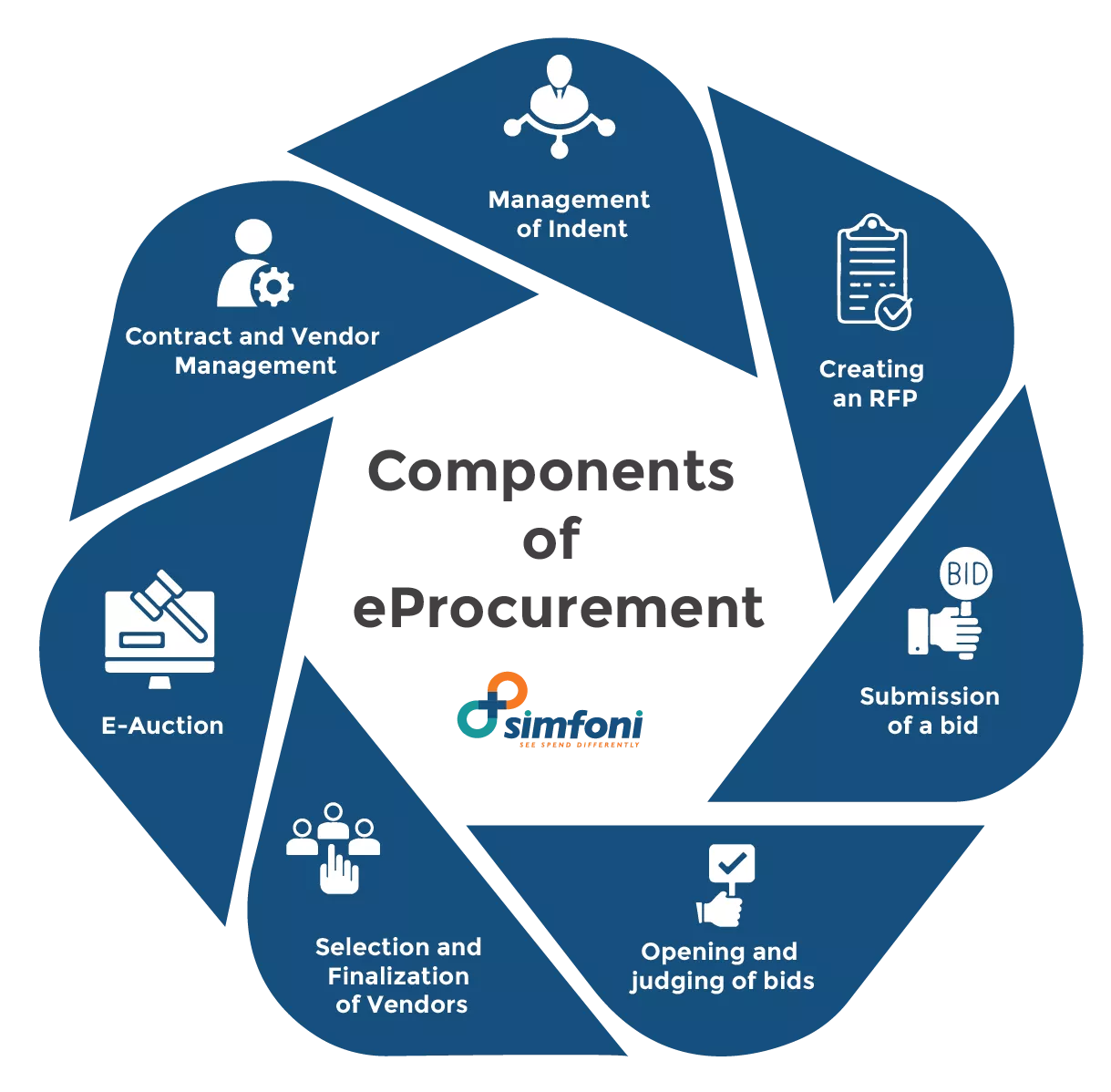
1. Management of Indent
It is the initial stage in the e-tendering, indent creation, or requisition creation process. This is followed by a review and approval process. It is also referred to as the workflow involved in the production of tenders and the indenting procedure defined by procurement departments. Complete works are submitted and obtained through the internet via e-Procurement.
2. Creating an RFP
A few key phrases used in e-procurement procedures include Request For Proposal (RFP), Request For Information (RFI), Request For Bids (RFB), and Request For Quotes (RFQ). This also entails establishing commercial certification standards. This draws several potential bidders and encourages them to participate in the business.
3. Submission of a bid
Bidders are required to register on the e-procurement site before submitting their bids, which must include all technical information and commercial procedures.
4. Opening and judging of bids
After the vendors’ information is uploaded to the e-procurement site, they are evaluated for their legitimacy, which is where the process of e-Auction takes place. All supplied information is double-checked for accuracy and compatibility.
5. E-Auction
An e-auction is conducted only based on needs. These auctions are where commodities that need to be acquired are judged worthy of being procured.
6. Selection and Finalization of Vendors
Following the e-Auction, one or more vendors are chosen, and a Purchase Order is issued by the specifications. The procurement process comes to a close with this phase.
7. Contract and Vendor Management
Maintaining vendor contact information as well as creating a catalog with all commercial information on bids.
What are the Benefits of eProcurement?
Procurement management within a purchasing company can benefit significantly from e-procurement, which includes :
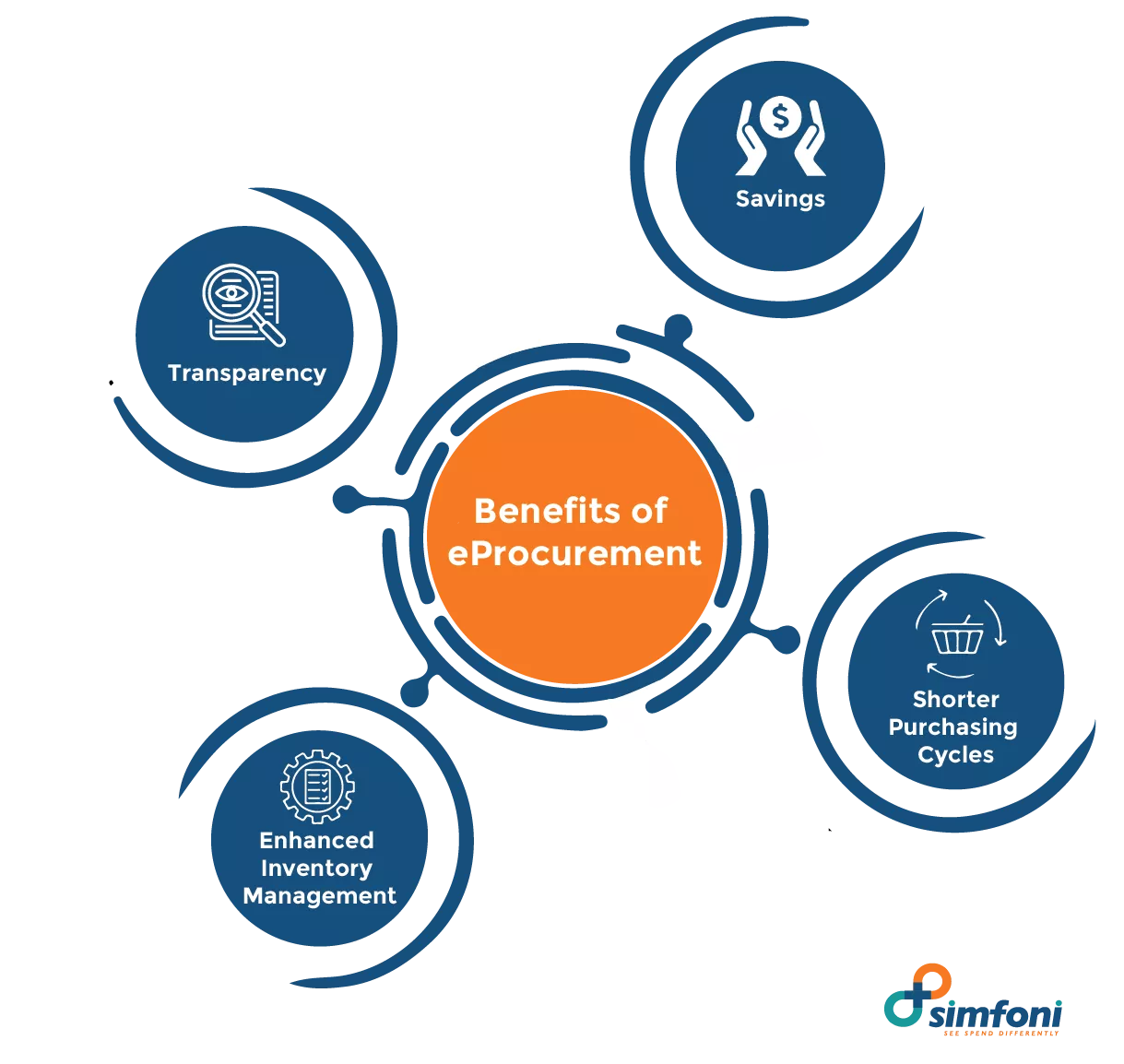
1. Savings
Built-in cost-control and performance-optimization technologies help reduce expense and paperwork while increasing efficiency. Fully automated systems can speed up the process of producing and fulfilling orders. A wider range of products and services is also possible.
2. Shorter Purchasing Cycles
Centralized transaction monitoring makes reporting on orders, payments, and requisitions easier, as well as guarantees contract compliance, all of which can help speed up delivery. Buyers can view offered items, services, and pricing on a computer screen.
3. Enhanced Inventory Management
Procurement experts can rapidly identify items from preferred vendors and are limited in the number of purchases they may make, allowing for improved inventory control.
4. Transparency
All data is consolidated and may be shared with management, stakeholders, shareholders, or the general public as needed.
The eProcurement Process
The traditional procurement cycle is paralleled by the e-procurement process. In e-procurement, there are five basic digital procedures. These steps correspond to the stages of the traditional procurement process: requirement definition, sourcing, solicitation, evaluation, contracting, and contract administration.
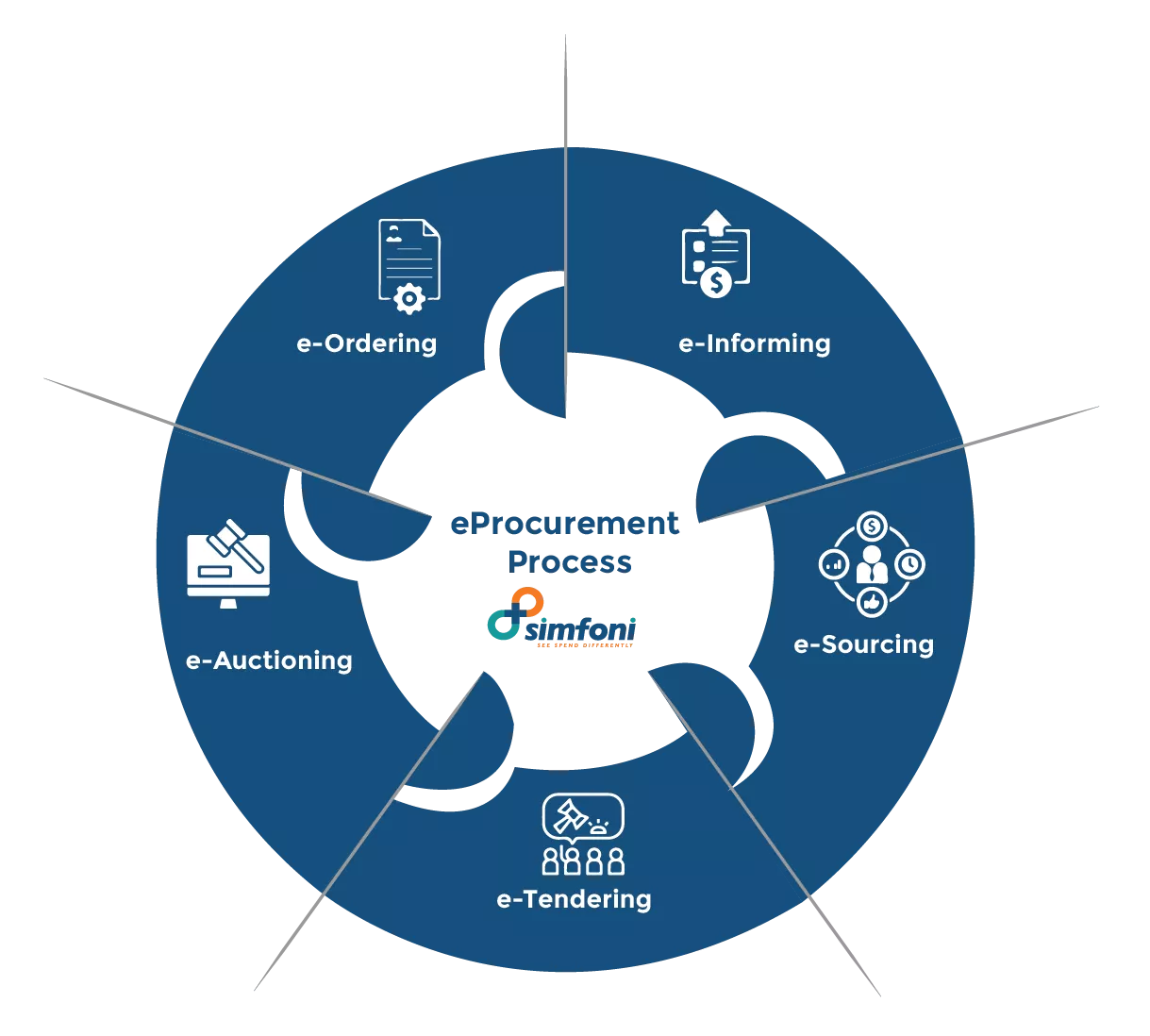
e-Informing
All steps of the traditional procurement cycle are covered by e-informing. It also intersects with all e-procurement digital procedures. E-informing entails a two-way exchange of confidential data. The communication takes place between internal and external partners inside the company, helping the organization to improve its e-procurement procedures.
e-Sourcing
The first phase of e-procurement is e-sourcing, which includes requirement definition and sourcing. It entails pre-qualifying potential suppliers based on the needs of the procurement firm to narrow down vendors for the assessment stage.
e-Tendering
Solicitation and assessment are both parts of the e-tendering process. It entails seeking information, proposals, and quotes from the suppliers that have been shortlisted. This aids in the procurement organization’s analysis and evaluation of vendors. The procurement organization employs technologies at this stage to guarantee transparency during the selection process.
e-Auctioning
E-auctioning, also known as e-reverse auctioning, is linked to contracting and evaluation. The parties engaged at this stage negotiate price and contract conditions. The procurement organization purchases the products or services from the vendor after striking an agreement.
Many buyers compete in e-auctioning to contract with one provider by proposing greater prices. In e-reverse auctioning, on the other hand, numerous providers compete for a contract with a single customer by underbidding.
e-Ordering
E-ordering occurs at the same time as contracting and contract management. It entails generating and authorizing requisitions, placing orders, and receiving the things that have been placed on hold. Completed on-call contracts are indexed in a digital catalog at this level. Employees can visit this catalog at any moment and place an order. Managing suppliers and catalogs, integrating purchase orders, e-invoicing, and e-payment are all examples of e-procurement operations.
eProcurement Tools
In the field of eProcurement, numerous tools and methods are employed, including :
System for electronic data interchange
Data and information are exchanged between electronic devices via an electronic data interchange (EDI). EDI streamlines billing and order logistics by transmitting and storing messages and information from partner firms.
Platforms and apps for the internet
Businesses use several eProcurement technologies and online platforms, such as E-sourcing, E-tendering, E-auctioning, and E-ordering, to make day-to-day work easier. Email, as well as XML-based data transport, are widely utilized.
Tools for e-ordering and purchase
A web-based ERP and digital methods for eAuctions are two important instruments for goods purchase.
Functions of E-Procurement
eProcurement’s principal duties are extensive, providing a variety of advantages for a company’s day-to-day operations and supply chain activities. The major functions of e-procurement for business are listed below :
- Reduces mistakes and frees up resources by automating operations.
- Simplifies the procurement cycle by improving communication between stakeholders and partners.
- Provides a consolidated platform for monitoring and auditing all procurement activities, offering stakeholders and management a single point of contact.
- Provides suppliers, managers, stakeholders, and partners with real-time updates as well as the ability to organize and preserve procurement data.
- Facilitates collaboration amongst numerous partners and stakeholders.
How does eProcurement Work?
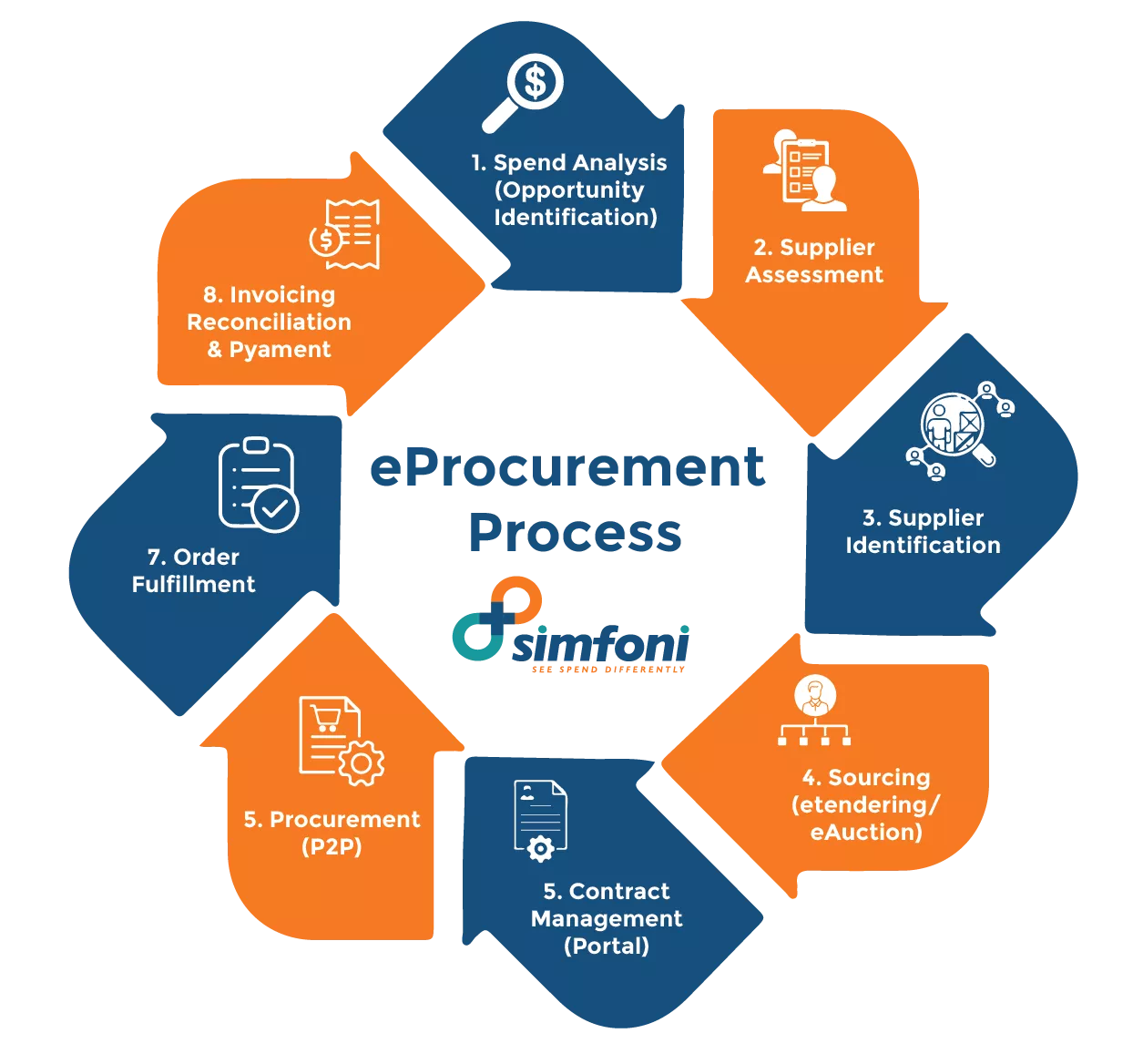
The goal of e-procurement is to make a company’s procurement operations more standardized. Manual operations such as pursuing a supplier to sign and email a contract to analyze savings for the year may be automated with cloud-based procurement software, resulting in considerable cost savings.
E-procurement reduces the need to do time-consuming procurement operations including e-auctions and e-tenders, exchanging supplier contracts, and filling out supplier onboarding questionnaires by hand.
The method involves using a centralized platform to link diverse organizations and processes. One of the most critical parts of electronic procurement is vendor/supplier management. It entails both the management of supplier relationships as well as the administration of supplier data.
The following are some of the most important elements of e-procurement solutions :
- Vendor onboarding and management: Using supplier onboarding questionnaires, gather data on various vendors or suppliers, and create partnerships with your chosen providers.
- Market research: When looking for suppliers, compare your alternatives using broad market visibility.
- Requesting information, obtaining quotes, and negotiating supplier contracts through the internet.
- Online transactions: This includes creating and processing electronic orders and purchasing requisitions, as well as any other part of completing an online transaction.
- Spending analytics: gathering and analyzing spending data to make better business decisions in the future.
Because these operations are automated, there are less potential for a human mistake and more resources are available for other procedures. It also entails better communication between companies, partners, stakeholders, and vendors.
Finally, a growing number of e-procurement services are being offered via the cloud. Because most of the technical work is done on the vendor’s side, these « e-procurement-as-a-service » systems offer the inherent advantages of being simple to implement and upgrade.
E-Procurement Software
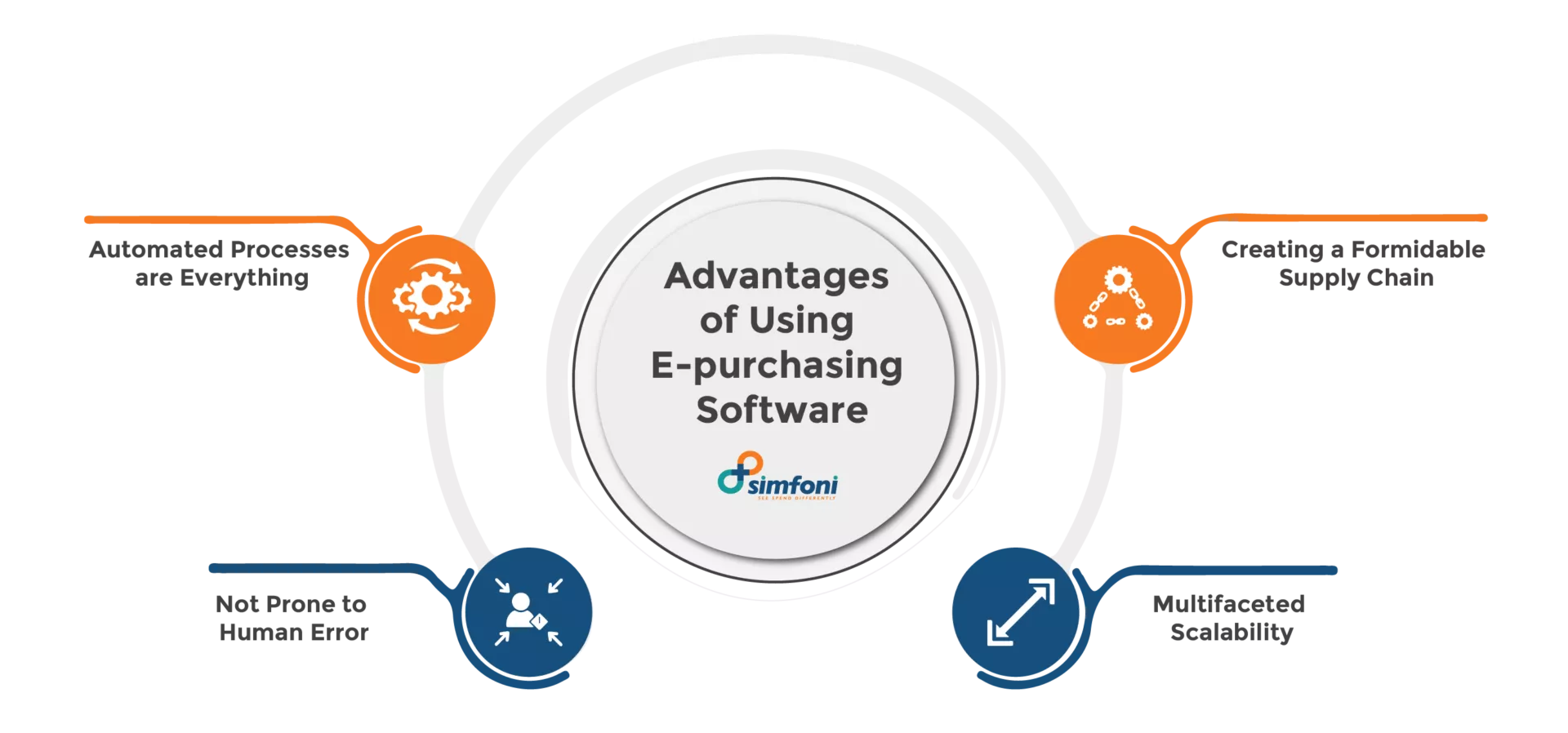
You must first choose and set up e-procurement software for e-procurement to operate in your firm. Simfoni provides everything your business needs to properly perform e-procurement, even if features and functionalities differ from one vendor to the next. It eliminates the requirement for paper-based operations and eliminates the need for time-consuming and error-prone human processes through automation.
The e-procurement process is made easier using e-procurement software. Procurement personnel can also automate a variety of tasks, processes, and procedures, such as policies, contracts, and vendor relationships.
The software’s primary advantage is that it speeds the procurement process and removes manual or paper-based operations, despite the fact that offered functions and capabilities differ by vendor.
Many e-procurement systems provide capabilities that enable procurement managers to personalize the procurement process. Additionally, they can :
- Identify which users will have access to which things ;
- Limit who has access to the budget data ;
- Control who has the authority to approve purchase requisitions, as well as who has the authority to examine and pay bills.
Mobile devices such as smartphones and tablets may access several e-procurement systems.
What are the E-procurement challenges?
When it comes to deploying and integrating e-procurement software with other business back-end systems, there are certain possible stumbling blocks.
Another problem is teaching staff how to utilize it. Companies must also collaborate with their suppliers to guarantee a smooth transition to the new online system.
Advantages Of eProcurement
The broad features of E-Procurement software may assist firms of any size, sector, or age that wish to simplify and improve their procurement department. Companies can benefit from e-procurement by :
The control and efficiency of the process have improved. Artificial intelligence and machine learning are strong process automation techniques that may be used to :
- Create access to shared data that is tiered and role-based.
- Create touchless workflows for all of your important tasks (complete with routing contingencies for approvals)
- Integrate vendor catalogs with contract management to ensure that every order for products and services is placed with the best vendor, at the best price, with the greatest terms and incentives—all while avoiding the risk of maverick spending or invoicing fraud.
- Integrate procurement with your current software to obtain even more efficiency.
- Better organization and communication. Everyone is on the same page with centralized, cloud-based data management, whether they’re in the office or working on their tablet, laptop, or smartphone thousands of miles away.
- Integration and automation Remove bottlenecks, obstacles, and unnecessary human error to increase overall efficiency while lowering expenses and waste.
- Using critical data analytics tools to extract actionable insights and valuable projections based on complete, trustworthy data is also easier with centralized and comprehensive data storage.
- Significant cost-savings opportunities Through both initial and ongoing efficiency gains, process optimization produces immediate and long-term cost reductions. Your employees can shift their emphasis away from low-value jobs and toward high-value ones. You may save even more money by lowering your expenses, hiring fewer people, or investing in new gear, software, or even office supplies (automated, digital processes use far less paper and materials than traditional, manual workflows).
E-Procurement software not only saves your firm money through process efficiencies but also has a tiny IT footprint. By investing in a customized, purpose-built procurement software system, you may create a truly cost-effective solution.
Simfoni, for example, specializes in procurement software solutions that contain all of the capabilities your company needs without adding extra bloat—all while allowing for future scalability and expansion in a seamless and non-disruptive manner.
What are the steps involved in E-procurement?
Specific to the Procure to Pay process, e-procurement consists of three primary steps :
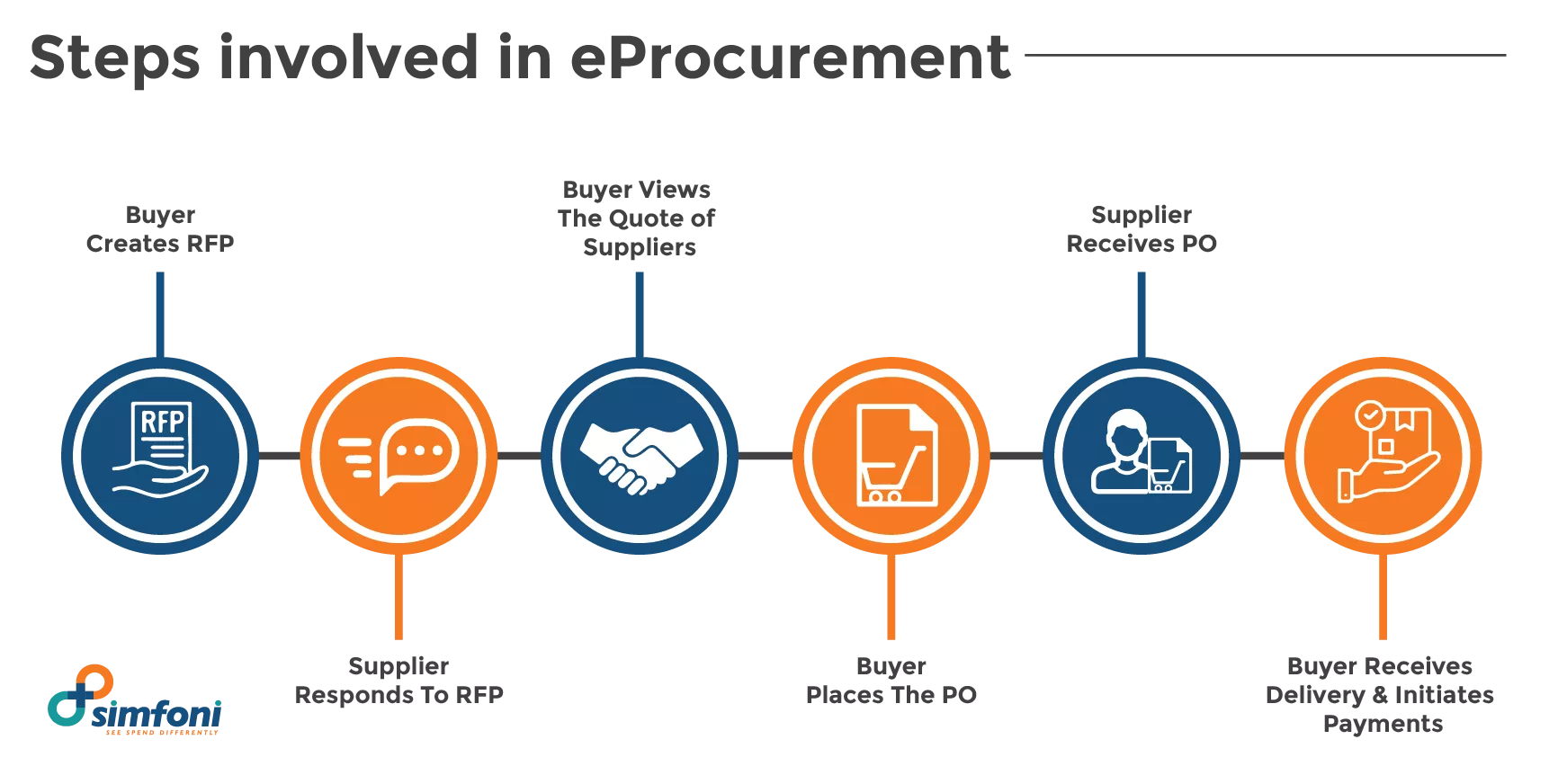
1. Picking a product
Businesses operate on a platform, which might be an online catalog, A B2B e-commerce site, or another type of platform provided by a marketplace. They then have access to the whole product range of the provider, including contractual terms (selected products, discounts, etc.).
With a single click, they select their items and submit a purchase request. The purchase request is subsequently entered into their buying system and processed according to a predetermined process.
2. Placement of the order
The purchase request becomes an order after it is verified. This is delivered to the relevant provider as an electronic document or through a marketplace. The supplier then prepares the merchandise for delivery right away.
3. Invoice receipt
The invoice can also be dematerialized, which means that companies get the invoice as a PDF file or electronic document, which immediately accepts the order and initiates payment.
What exactly is E-Procurement software?
E-procurement software is a web-based solution that allows you to handle all parts of your procurement process. Its goal is to make procurement more user-friendly, automated, and streamlined, allowing users to view tender documents from anywhere in the globe, with different user privileges depending on their job title and position in the tender process.
E-procurement is the buying and selling of supplies, works, and services through the internet by businesses, consumers, and government agencies. It includes the complete process, from the moment a purchase decision is made, through the interaction between buyers and suppliers, to the invoicing system, and delivery after the goods, works, or services specified in the tender specification have been delivered. Every part of procurement is covered by eProcurement software, which enables safe document production, interchange, and storage.
What is the difference between E-Procurement and E-Marketplaces?
E-Procurement
E-procurement (electronic procurement) is the process of purchasing and selling products and services through the internet. For example, John might simply look for suppliers online and place his milk order that way. The following technologies are used in the e-procurement process :
- E- informing
- Vendor administration
- Catalog administration
- E-invoicing
- E-payment
In the public sector, e-procurement is so popular that many governments have included it in their current e-government projects. Governments have done this to guarantee that services and products are delivered to residents more effectively and efficiently.
E-Marketplace
E-marketplaces are frequently used for e-procurement. An e-marketplace is a web-based environment where buyers and sellers may meet and transact business. It’s the digital equivalent of going to market. Rather than traveling to a certain section of town and browsing the stores, one may go online and explore websites that provide things for sale by a variety of online merchants. E-marketplaces are a vital tool for boosting e-commerce. E-marketplaces may be classified into the following categories :
1. E-marketplace that is self-contained.
This model’s primary goal is to make money. A third-party-managed B2B platform that allows buyers and sellers from a certain sector to connect. When a party registers on a third-party e-marketplace, it receives quotes or bids in a certain industry.
2. The market that caters to buyers
A group of persons with similar commercial interests joins forces to promote a smooth purchasing environment. This allows a party to build enough negotiating power with a supplier to get the desired price. This marketplace can also benefit suppliers by providing them with a consumer base with whom to share their catalog.
3. Marketplace with a focus on suppliers
Supplier’s directory is another term for this sort of marketplace. It gives the merchant a platform to increase their awareness through various communication channels. The vendors will be able to reach out to a huge number of potential customers.
4. A marketplace that is both horizontal and vertical.
Buyers and suppliers from various sectors or areas can join together to complete a transaction in a horizontal marketplace.
Vertical marketplaces allow access to diverse areas of a certain industry at various levels of the hierarchy via the internet.
Why E-procurement Marketplace?
The Simfoni platform conducts all purchasing on one of the several internet marketplaces. In our working lives, however, this occurrence is far rarer. Only one in three buying departments were digitalized by the end of 2019, according to an Opinionway survey for Office Depot. Using e-procurement platforms, on the other hand, provides several benefits. There are four compelling reasons to build an e-procurement platform: time savings, cost savings, process optimization, and improved control.
Create an e-procurement marketplace to save time.
The e-procurement platform simplifies the whole sourcing cycle thanks to ergonomics akin to B2C markets, catalog optimization, better search, and centralized processing.
The e-procurement markets are modeled after the ones we all use regularly. They are simple to use and save time for consumers, buying managers, and suppliers alike.
Indeed, the reason we enjoy these virtual markets so much in our daily lives is that everything is offered in one location. This implies that professionals no longer need to go through a plethora of catalogs or websites to get the product or service they want. They’re all in the same catalog, with references that may be sorted and filtered to meet your specific requirements.
Purchasing managers, for their part, no longer waste time manually integrating catalogs into their ERP (Enterprise Resource Planning) system. Suppliers may immediately integrate and update their products and services on the platform for all of their clients. This centralized administration also allows sellers to receive immediate notifications each time an order is placed, which speeds up order processing.
Establish an e-procurement marketplace to save money
Using a B2B marketplace may save money on numerous levels: administrative buying management can be reduced and optimized, inventory management can be optimized, and transactions can be done at the best costs owing to transparent competition.
For businesses, shortening the procurement period provides major cost savings. Buyers are liberated from low-value-added chores and the risk of mistakes since the administrative load is partly passed to suppliers and partially automated.
Reducing the time it takes to place an order and, as a result, get the items, allows you to minimize stock and make inventory management more convenient, which saves storage space and management expenses.
It’s feasible to analyze multiple bids and discover the greatest quality/price ratio when numerous providers are in the same e-procurement marketplace. Furthermore, pricing transparency encourages suppliers to be more competitive, allowing for price regulation and the greatest potential purchase price.
Create an e-procurement marketplace to streamline your purchase process.
Creating a marketplace that is tailored to its target market enables digitalization and mutualization of the purchasing process, allowing for improved sourcing and purchase optimization.
Even though the majority of businesses no longer handle their purchases manually, ERPs do not always deliver the best user experience. E-procurement marketplaces connect to current ERPs and provide a purchase experience that is comparable to what customers have in their everyday lives. As a result, they gain from being in a comfortable and well-known setting. This promotes their utilization while lowering the danger of mistakes.
Managing purchases is automated, dematerialized, and has the advantage of putting all of the procedures (purchase orders, validations, invoices, and so on) on the same platform, which eliminates lost papers, duplication, and other issues.
All potential issues are also centralized and managed by a single point of contact, the platform manager, who is in charge of resolving conflicts. Everything may be done using an e-procurement platform, whether it’s strategic or indirect purchases. Indeed, these marketplaces are well-suited to B2B transactions, and they adapt to varied user profiles by combining purchasing policies (limits, validations, and so on) and offer procedures (quotes, negotiations, and so on), allowing businesses to better manage and limit uncontrolled purchases.
The purchase process may be centralized, and monitoring features like notifications, reports, and transaction history can help you keep track of your expenditure. Thus, purchasing behaviors may be simply analyzed and used for forecasting, goal-setting, and process improvement.
E-procurement systems allow for the reference of an endless number of vendors, making them an excellent tool for simplifying one’s supplier portfolio. Having a clear perspective of the competition indeed makes it easier to choose the best deal. This is especially true if the platform incorporates a product and service rating and review system.
To have more control over the purchases, set up an e-procurement marketplace.
As a result of being armed with high-performance digital tools that cover the whole purchasing process, the purchasing manager may take on a more strategic role of control and optimization. Setting up an e-procurement marketplace saves time and money by establishing a more efficient and regulated purchasing process. But what about payment security and onboarding suppliers? Lemony, like a Payment Service Provider (PSP), plays this responsibility. We assist markets in managing payments to provide a more seamless and optimized client experience.
Steps to Implementing an E-Procurement Strategy
The procedures of vendor selection, payment conditions, contract discussions, and items purchase are all part of your e-procurement strategy. When we consider the global setting in which we now operate, e-procurement is growing more popular, assisting firms in being more efficient. E-procurement streamlines the purchase and processing operations by allowing pre-approved vendors to communicate with customers regardless of their location. The steps are as follows:
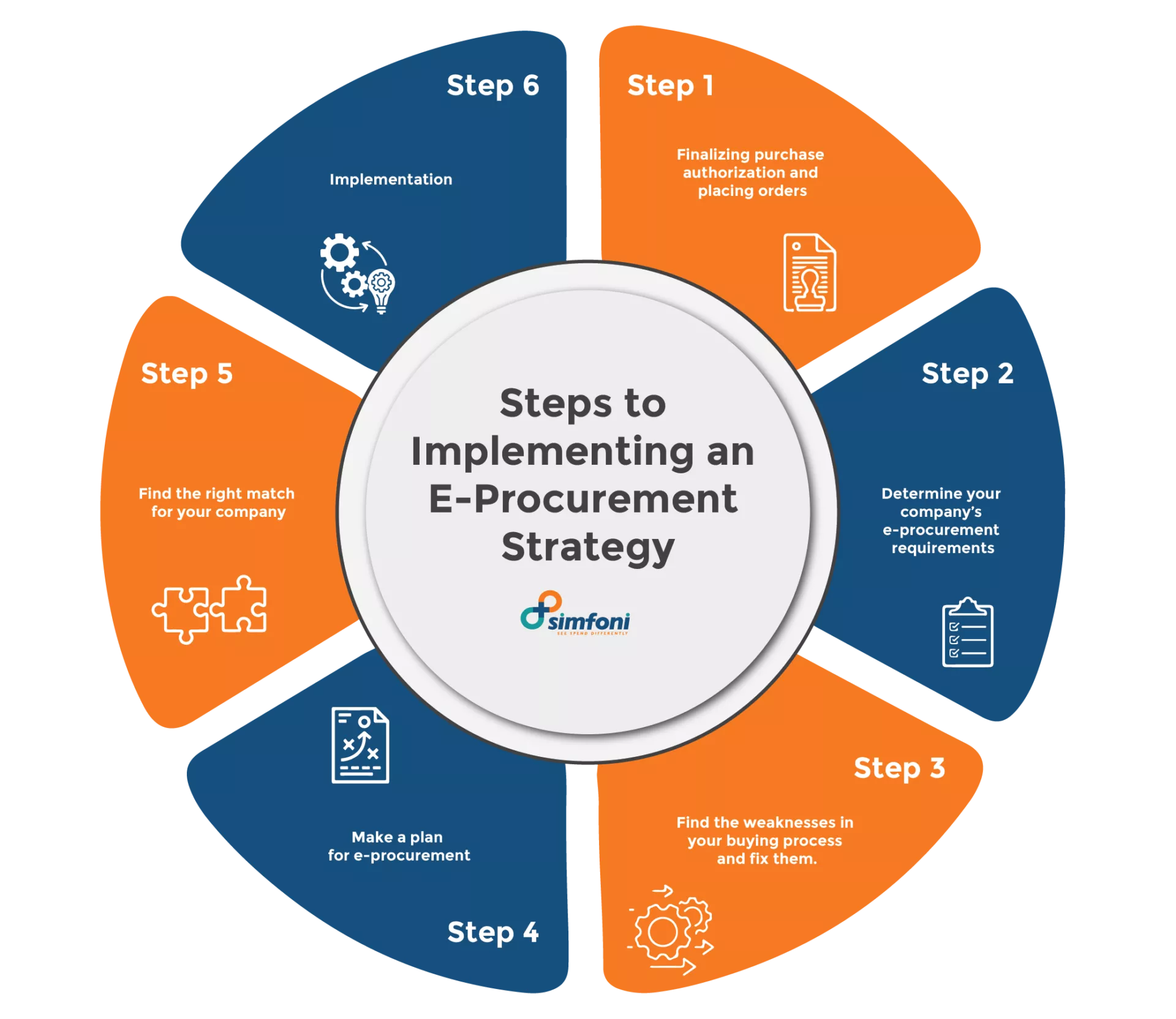
Step 1: Finalizing purchase authorization and placing orders will take only a few minutes.
As a result, delivery times are reduced, which translates to higher customer satisfaction. Each minute might cost you money in business. As a result, establishing an e-procurement strategy will result in considerable time and cost savings for your company. Continue reading to learn about the most crucial measures you’ll need to take to establish your e-procurement strategy.
Step 2: Determine your company’s e-procurement requirements.
You started a typical procurement procedure when you started your company, and it served you well until now. Even though there is always space for development, e-procurement is not always the best option.
As a result, before embarking on this journey and investing money in your e-procurement plan, you should examine and record your present and prospective procurement processes. You may make a visual representation of your current buying operations.
You’ll have a comprehensive picture of how your actual procurement process works, making it easier to determine whether e-procurement is truly necessary for your company. You may, for example, determine the existing and intended delivery and other work timelines, determine which suppliers are involved, examine the agreed payment methods, and much more.
After you’ve documented everything, you can figure out what procurement arrangements your company needs to meet today’s client expectations and prepare for future growth. When preparing for a change in your company procedures, it’s usually a good idea to start by assessing your existing scenario. Make a diagram of your present process to see what parts of your procurement strategy are missing. Then it will be extremely simple to determine the best e-procurement plan to enhance your efficiency.
Step 3: The weaknesses in your buying process and fix them.
Once you’ve determined what you need from your e-procurement strategy, the problems in your real procurement process will become evident.
For example, you can be having problems with your suppliers, or you might have late orders that irritate your customers. Understanding the main reason and outlining all the gaps that make your business less efficient is the first step to improving your existing condition.
You may start thinking about ways to bridge those gaps once you’ve recognized them and know exactly what you need. For example, you could learn that your list contains some untrustworthy vendors who are causing havoc in your present procurement process. As a result, the answer is self-evident. You should go over your supplier list and evaluate your present collaborators in depth.
Step 4: Make a plan for e-procurement.
Before you begin designing your e-procurement strategy, make a list of the advantages of utilizing it in your company. This list will come in handy, especially when it comes time to pitch the project to management. Once your e-procurement strategy has been approved by management, it’s time to plan each phase and establish clear KPIs. You’ve reached the point where you can identify the gaps in your present process and your aspirations for the future e-procurement process.
When drafting each phase of your e-procurement implementation plan, keep in mind the human and financial resources required, as well as where you can get additional information about the process and who you can contact if you need assistance. In addition, you should establish specific KPIs for each step and monitor their progress. If things don’t go as planned, you should have a strategy in place to fix them. As a result, you will prevent delays as well as any additional charges.
Step 5: Find the right match for your company.
Before you pick the best e-procurement solution provider, you need to think about a few things. Your budget and company requirements are two major elements that will influence your decision. However, the cost should not be the sole factor in your selection. You should also consider the value you receive concerning the price you spend. Even if the price you receive is higher than your budget, it is worthwhile to pay. Of course, as long as you obtain high-quality services and comprehensive e-procurement solutions, this is possible.
Step 6: Implementation
It’s time to start implementing your e-procurement provider once you’ve made your decision. As long as you identify your team’s roles and duties, this should be a simple procedure. The implementation procedure needs your undivided attention and substantial resources.
As a result, you should make sure you have enough resources to implement your e-procurement plan regularly. On the other side, you should avoid putting undue pressure on your employees.
When you decide to adopt an e-procurement strategy in your company, it’s critical to understand the implications. As a result, communication is critical throughout the process. Speak with your coworkers and supervisors. Find out what the major advantages of implementing an e-procurement strategy are for your company. Your firm will become stronger and better equipped to fight the competition once you’ve adopted it.
What is Source to Pay – A Guide to Source-to-Pay (S2P) Process
Benefits of E-Procurement Solutions
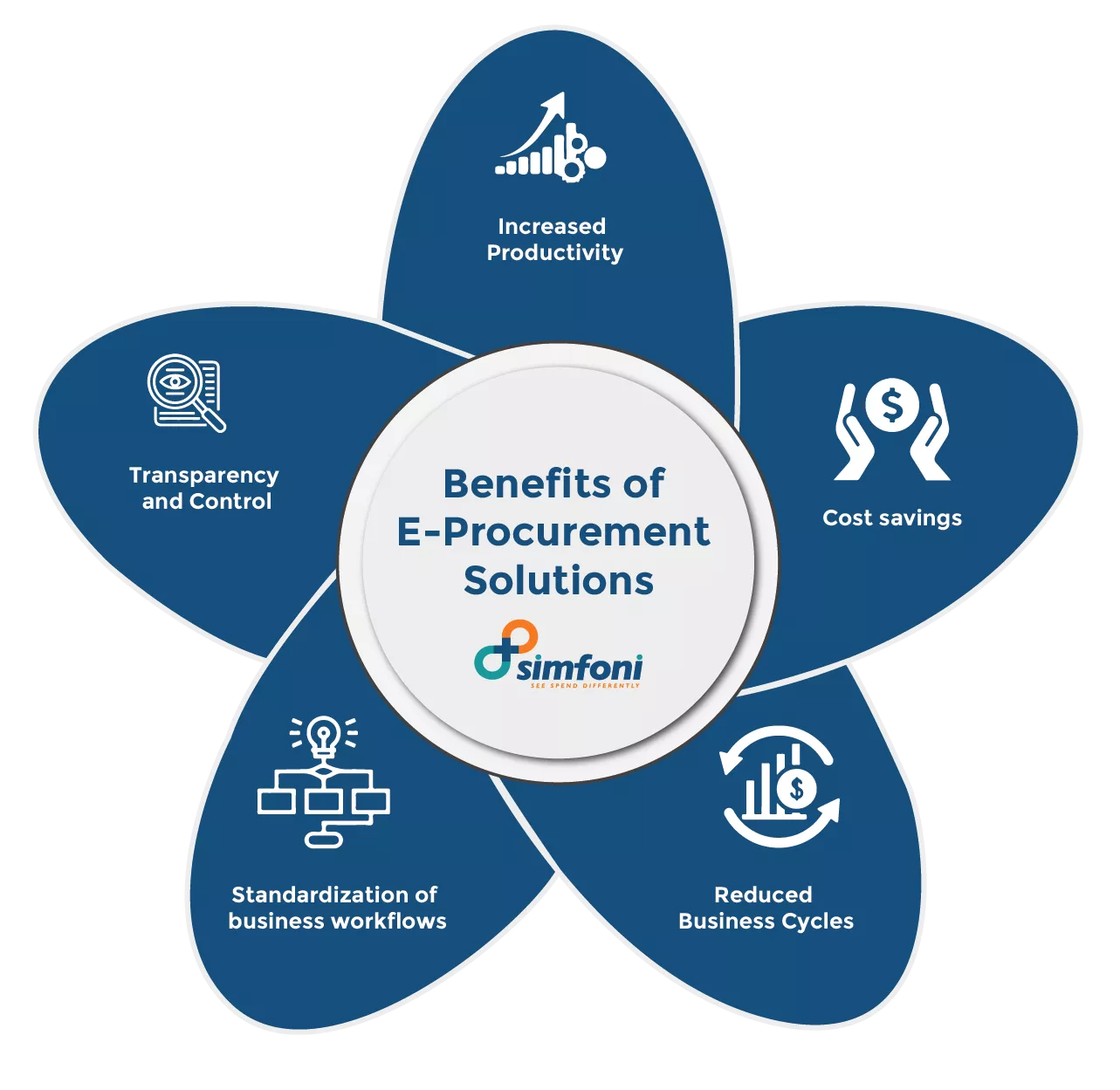
- Increased Productivity through improved efficiency in areas like ordering, invoicing, approvals, and payments by automating processes.
- Cost savings due to the elimination of paperwork and the expenditures associated with paper procedures.
- Reduced Business Cycles through the use of real-time as part of the automation process and increased transaction completion capability.
- Standardization of business workflows, purchase order approvals, and quotation and proposal requests.
- Transparency and Control of Tracking promote visibility by ensuring end-to-end transparency of all procurement transactions.
Top reasons should buy E-Procurement software
- A User-Friendly Interface: Filling out forms, generating invoices, and submitting them to the appropriate people should all be done with a single click.
- Real-Time Conversation: Seamless real-time integrations avoid wasteful spending and help you stay on track with your budget.
- Speed and Flexibility: With the advancement of new technologies and cloud computing, the implementation time has been reduced from months to days, and each organization’s setup procedure is unique.
- Automated Approval Process: The workflow parameters are specified by the procurement department or at the management level, and the approval should be automated at the user and corporate levels.
- Mobile Access: In the event of a natural disaster or a pandemic, such as COVID-19, the organization must be prepared to operate remotely. eProcurement software’s flexibility allows it to handle approvals through mobile anytime, anywhere.
E-Procurement in Modern Context
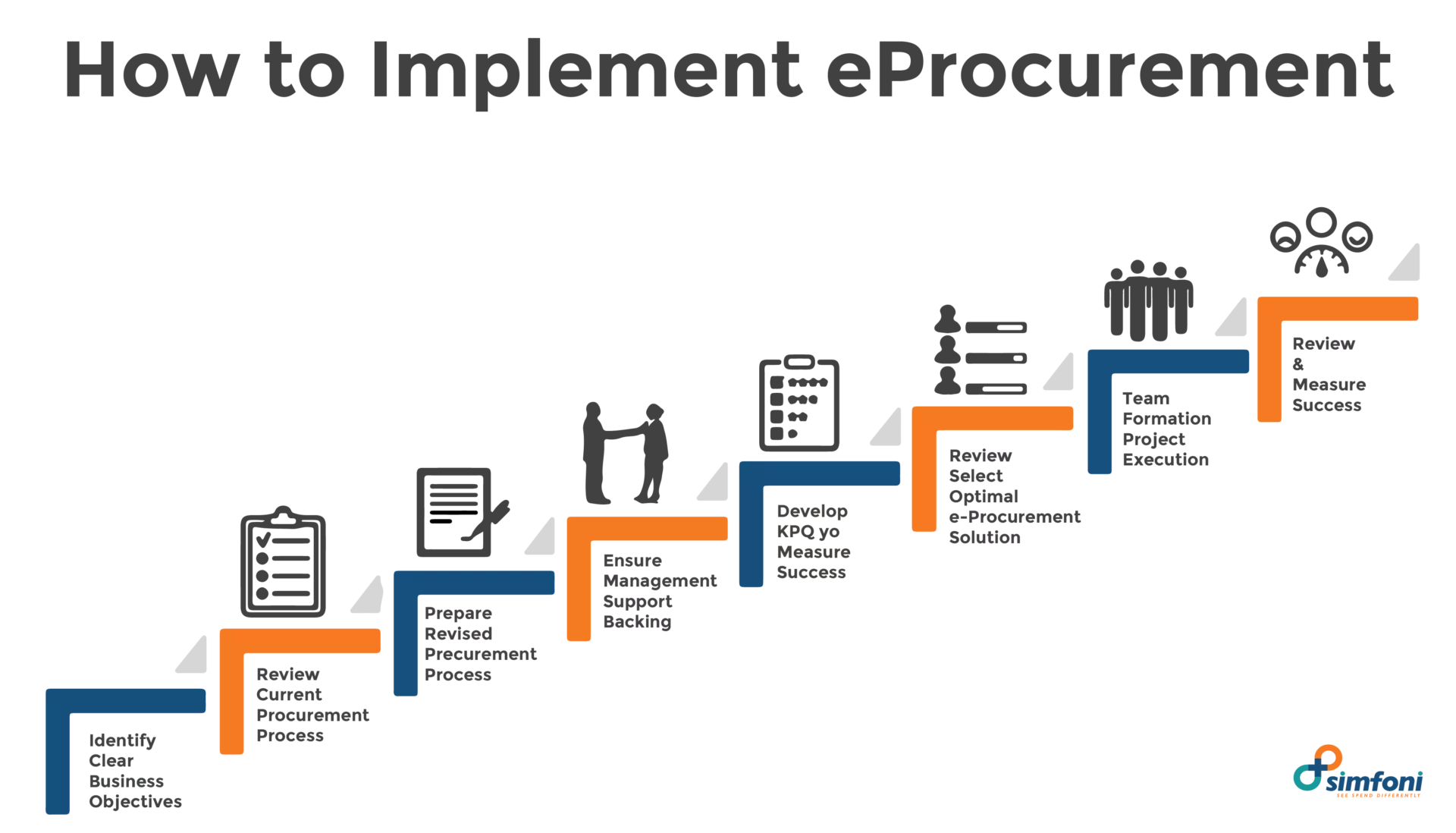
eProcurement now encompasses activities such as eAuctions and eTenders for assessing and selecting suppliers, as well as what you need to buy from these vendors, such as electronic orders and supplier catalogs.
Procurement automation aids in the transformation of company’s growth at scale.
The impact of cost savings comes from considerably buying items from the vendor at the appropriate time and at the correct price. As a result, procurement automation is the answer to making your day-to-day duties easier, and technology today will bring significant value.
- Simplifies the approval procedure by totally automating purchase orders and allowing for speedy order placement at times.
- Allows you to see what you’ve spent in the past. Automation remains in creating the proper quality data for greater visibility on spending by retrieving an accurate report of prior purchases, order history, supplier quotations, contracts, and many others.
- Promotes transparent contact with suppliers through automation, making real-time communication and order tracking easier for both customers and suppliers.
- All contracts are stored in one location and may be accessed with a single click.
- With One-Click Access to All Functions, the essential information is quickly available without having to navigate through various systems, resulting in a boost in overall productivity.
Conclusion:
E-Procurement platforms provide you with more flexibility and control throughout the whole purchase process. Control is fundamental to the contemporary e-Procurement system, from who can place an order to who can approve and purchase it, and lastly who can receive against or pay it.
Frequently Asked Question (FAQ)
For your help, we have created a list of answers to assist you more.
What is eProcurement?
eProcurement is defined as a digital business-to-business (B2B) process that leverages internet technology to centralize and streamline purchasing workflows for the procurement of goods and services. This digital approach aims to reduce costs and enhance the efficiency of purchasing processes within organizations. eProcurement software replaces traditional paper-based operations by automating procurement procedures and facilitates the analysis of spending for strategic cost-saving collaboration between finance and procurement departments.
eProcurement software typically integrates various functionalities, including spend analysis, eSourcing, e-auctions, procure-to-pay (P2P), marketplaces, and contract management. By offering a centralized system, eProcurement enhances efficiency and ultimately lowers the overall procurement costs.
In summary, eProcurement is an electronic means of requisitioning, ordering, and purchasing goods and services online. It plays a vital role in centralizing and automating interactions between organizations, customers, and other value chain partners, thereby improving the speed and efficiency of procurement practices while reducing potential errors and costs associated with manual processes.
What are the advantages of e-procurement?
E-procurement, or electronic procurement, offers numerous advantages for businesses and organizations:
- Cost Savings: E-procurement reduces paperwork, manual processes, and the need for physical storage, leading to significant cost savings.
- Efficiency: It streamlines procurement processes, making them faster and more efficient. This leads to quicker order processing and reduced lead times.
- Transparency: E-procurement provides real-time visibility into procurement activities, making it easier to track orders, monitor supplier performance, and ensure compliance.
- Supplier Collaboration: It enables better collaboration with suppliers through online portals, facilitating communication and negotiation.
- Improved Accuracy: Automation reduces errors in data entry and order processing, minimizing costly mistakes.
- Centralization: Centralized procurement systems allow for better control and standardization of purchasing practices across an organization.
- Marketplace Access: E-procurement platforms often provide access to a wider range of suppliers and products, increasing competitive advantages.
- Data Analytics: It allows for the collection and analysis of procurement data. This can be used to make informed decisions and optimize procurement strategies.
- Compliance: E-procurement systems can enforce procurement policies and regulations. This ensures adherence to legal and ethical standards.
- Environmental Benefits: By reducing paper usage and optimizing supply chains e-procurement contributes to sustainability and reduces carbon footprint.
What are the disadvantages of e-procurement?
While e-procurement offers many benefits. It also comes with some disadvantages:
- Initial Costs: Implementing e-procurement systems can be expensive, including software, training, and infrastructure upgrades.
- Complexity: Complex systems may require a significant learning curve for users and administrators.
- Security Concerns: Handling sensitive data online can pose security risks if not adequately protected.
- Supplier Resistance: Some suppliers may be hesitant to adopt e-procurement systems, leading to challenges in integration.
- Technical Issues: System downtime or technical glitches can disrupt procurement processes.
- Dependency on Technology: Organizations become reliant on technology, which can be vulnerable to failures or cyberattacks.
- Limited Personal Interaction: E-procurement reduces face-to-face interactions with suppliers, which may impact relationships and negotiations.
- Customization Challenges: Tailoring e-procurement systems to specific organizational needs can be challenging.
- Change Management: Employees may resist the shift from traditional to electronic procurement methods, requiring effective change management strategies.
- Supplier Selection: Choosing the right e-procurement tools and suppliers can be a complex decision-making process.
What are the stages of e-procurement?
E-procurement typically involves several stages:
- Identification of Needs: Identifying the goods or services required and creating a procurement request.
- Vendor Selection: Choosing suppliers through a vendor evaluation process.
- Purchase Order Generation: Creating purchase orders detailing the terms and conditions of the purchase.
- Order Approval: Reviewing and approving purchase orders before sending them to suppliers.
- Order Transmission: Sending purchase orders electronically to selected suppliers.
- Order Confirmation: Receiving order confirmations from suppliers.
- Goods/Service Receipt: Confirming the receipt and quality of goods or services.
- Invoice Processing: Receiving and processing electronic invoices from suppliers.
- Payment: Initiating payments to suppliers based on approved invoices.
- Supplier Performance Evaluation: Assessing supplier performance and making improvements as necessary.
What are the 4 types of e-procurement?
There are four types of e-procurement
- Catalog Management: Involves the creation and management of online catalogs with predefined products and prices. This can simplify procurement process for standard items.
- Supplier Exchange: Facilitates collaboration with suppliers through online portals for activities like bidding, negotiation, and order management.
- E-Sourcing: Focuses on the strategic sourcing process, including supplier identification, RFx (Request for Information, Proposal, Quote) creation, and supplier evaluation.
- E-Procurement Marketplace: Provides access to a wide range of suppliers and products, allowing organizations to compare and select suppliers easily.
What is main function of e-procurement?
The primary function of e-procurement is to automate and streamline the procurement process. It encompasses activities such as requisitioning, vendor selection. It also includes purchase order creation, order transmission receipt of goods , invoice processing and payment. E-procurement aims to improve efficiency and reduce costs. It can also enhance transparency and promote collaboration with suppliers.
What are the e-procurement tools?
E-procurement tools encompass a variety of software and technologies designed to support electronic procurement processes. Some common e-procurement tools include:
- E-Procurement Software: Comprehensive software solutions that automate and manage various procurement tasks.
- Supplier Portals: Online platforms where suppliers can interact with buyers, submit bids, and manage orders.
- Electronic Catalogs: Digital catalogs containing products and services available for purchase.
- RFx Tools: Software for creating and managing Requests for Information, Proposals, or Quotes.
- E-Invoicing Systems: Electronic invoicing solutions that streamline invoice processing.
- Inventory Management Systems: Tools for tracking and managing inventory levels.
- Procurement Analytics: Software for analyzing procurement data and making data-driven decisions.
- Contract Management Software: Platforms for managing supplier contracts and agreements.
What are the key elements of e-procurement?
Key elements of e-procurement include:
- Automation: Automating manual procurement tasks to improve efficiency and reduce errors.
- Electronic Documentation: Storing and managing procurement documents digitally.
- Supplier Collaboration: Facilitating communication and collaboration with suppliers through online portals.
- Integration: Integrating e-procurement systems with other enterprise systems like ERP (Enterprise Resource Planning).
- Compliance: Ensuring adherence to procurement policies and regulations.
- Data Analytics: Utilizing data analytics to gain insights and optimize procurement processes.
- Security: Implementing robust security measures to protect sensitive procurement data.
- Audit Trails: Maintaining a record of all procurement activities for transparency and compliance purposes.
- Cost Reduction: Using e-procurement to achieve cost savings through better negotiation and supplier management.
- Supplier Performance Monitoring: Continuously evaluating and improving supplier performance.
What are best practices for implementing e-procurement systems?
Successful deployment of e-procurement systems entails a lot of things. This includes planning, active stakeholder involvement, comprehensive training and commitment to ongoing enhancements. Additionally, organizations should factor in scalability and adaptability to accommodate their growth.
What are the potential risks associated with e-procurement?
Potential risks encompass data breaches system disruptions, supplier non-compliance legal and regulatory challenges and the necessity for continuous technology upgrades.
How can organizations ensure data security in e-procurement?
Implementing robust cybersecurity measures, encryption, access controls, and regular security audits can help safeguard sensitive procurement data.
What role does e-procurement play in SCM?
E-procurement significantly contributes to supply chain management through various key mechanisms. Firstly, it enhances procurement efficiency by automating processes and streamlining workflows, resulting in quicker acquisition of goods. Secondly, it reduces lead times by expediting the procurement cycle. Additionally, it improves inventory management by providing real-time visibility and control over inventory levels and demand forecasts.
What are the key trends in e-procurement for the future?
E-procurement plays an integral role in supply chain management . It does this by enhancing the efficiency of the procurement process, shortening lead times and enhancing inventory management.
How can organizations assess the effectiveness of e-procurement investments?
To gauge the impact of e-procurement, organizations can assess the costs associated with its implementation and upkeep in relation to the savings and advantages achieved. This assessment may involve quantifying cost reductions stemming from reduced paperwork, enhanced supplier negotiations, and shortened procurement cycles. Furthermore, monitoring enhancements in procurement efficiency supplier performance, and adherence to compliance standards can offer valuable insights into the effectiveness of e-procurement investments.
What role does e-procurement play in fostering sustainability?
E-procurement assumes a central role in advocating sustainability and environmentally-conscious procurement practices. It enables organizations to monitor and oversee the ecological footprint resulting from their procurement operations. By simplifying the identification of environmentally-friendly suppliers, products, and materials, e-procurement contributes to minimizing carbon emissions and achieving sustainability objectives. Moreover, it can facilitate the integration of eco-friendly sourcing methods and ensure alignment with environmental regulations.
How can smaller enterprises harness advantages of e-procurement?
Smaller businesses can harness the benefits of e-procurement, even when resources are limited. Cloud-based e-procurement solutions often present cost-efficient choices, necessitating minimal initial investments in hardware and infrastructure. These solutions are designed to scale allowing businesses to pay for the specific features they require as they expand. Furthermore, smaller enterprises can leverage e-procurement to access a wider range of supplier negotiate more favorable agreements and streamline their procurement processes, ultimately achieving cost efficiencies and operational improvements.
Useful Resources
- Cost Reduction Strategies in Procurement.
- Effective Procure-to-Pay Process Guide (P2P Procurement).
- Guide to eProcurement software & Solutions.
- Guide to Manage Tail Spend and Improve the Bottom Line.
- Guide to Procurement Software & eProcurement Solution.
- Guide to Understanding Category Management in Procurement.
- Leveraging AI & Machine Learning in Procurement.
- Procurement Analytics & Implementation.
- Procurement Management - Key Steps and Roles.
- Procurement Marketplace - Reinventing Procurement
- Savings Tracking Process in Procurement.
- Source to Pay Process, Steps & Definition.
- Spend Analysis in Procurement: Importance, Process & Examples.
- Supplier Diversity in Procurement
- Sustainable Procurement - Importance & Best Practices
- Understanding the What, Why, & How of Strategic Sourcing.
- Procurement Auctions – How It Works, Example, and Risks.
- Supply Chain Management (SCM): How It Works and Why It Is Important
- What is Contract Management - Everything You Need to Know
- B2B Marketplace - The Ultimate Guide to Procurement Marketplace
- Spend Management - Importance & Best Practices On Business Spend Management Software & Solutions
- Strategic Sourcing – Ultimate Guide To Strategic Sourcing Processes
- Spend Cube – Ultimate Guide to Spend Cube Analysis
- Procurement Software - Automate Your Procurement Process